
The genus Nestor is one of the two extant genera of the parrot family Strigopidae. Together with the kākāpō, and the extinct parrots in the genus Nelepsittacus, they form the parrot superfamily Strigopoidea. The Nestor's genus contains two extant parrot species from New Zealand and two extinct species from Norfolk Island, Australia and Chatham Island, New Zealand, respectively. All species are large stocky birds with short squarish tails. A defining characteristic of the genus is the tongue, which is tipped with a hair-like fringe. The superficial resemblance of this tongue to that of lorikeets has led some taxonomists to consider the two groups closely related, but DNA evidence shows they are not.
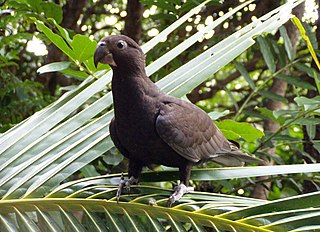
The greater vasa parrot is one of two species of vasa parrot, the other being the lesser vasa parrot C. nigra. The greater vasa parrot can be found throughout Madagascar and the Comoros.
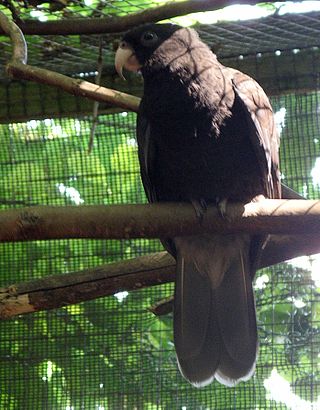
The vasa parrots that form the genus Coracopsis, are four species of parrot in the Old World parrot family Psittaculidae that are endemic to Madagascar and other islands in the western Indian Ocean. Some taxonomists formerly placed the species in the genus in Mascarinus, but this is now thought to be based on the results of a heavily flawed, later-debunked genetic study.

The lesser vasa parrot or black parrot is a black coloured parrot endemic to most of Madagascar. It is one of four species of vasa parrots, the others being the greater vasa parrot, the Seychelles black parrot, and the Comoros black parrot. The latter two were formerly considered conspecific with the lesser vasa parrot.

The Seychelles black parrot, Praslin parrot or kato nwar is a sombre-coloured, medium-sized parrot endemic to the Seychelles. Historically, it has been treated as a subspecies of the lesser vasa parrot, although it shows morphological, ecological and behavioural differences. Recent phylogenetic research indicates that the Seychelles population has a long history of isolation and may be sister to the rest of Coracopsis. It is the national bird of the Seychelles.

The Mascarene parrot or mascarin is an extinct species of parrot that was endemic to the Mascarene island of Réunion in the western Indian Ocean. The taxonomic relationships of this species have been subject to debate; it has historically been grouped with either the Psittaculini parrots or the vasa parrots, with the latest genetic study favouring the former group.

The blue-backed parrot, also known as Müller's parrot is a large, endangered species of parrot endemic to the Philippines. It is found in tropical moist lowland forests. Flocks are small and often active at night. Its main threats are habitat loss and trapping for the pet trade.
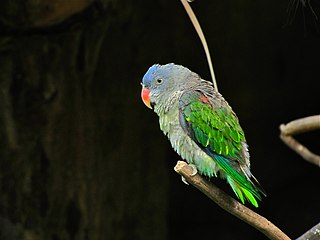
The blue-rumped parrot is a parrot found in the very southern tip of Myanmar, peninsular Thailand, Malaysia, Borneo, Sumatra and nearby islands. It is a small parrot (18 cm) and is primarily green with bright red underwing coverts, a reddish shoulder patch, and yellowish margins on the wing coverts. It is sexually dimorphic. The female has a grey-brown head. The male has a black mantle, red upper mandible, and blue head and rump.
Meek's lorikeet is a species of parrot in the family Psittaculidae. It is found on Bougainville Island in Papua New Guinea and the Solomon Islands. Its natural habitats are subtropical or tropical moist lowland forest and subtropical or tropical moist montane forest. It is threatened by habitat loss.
The striated lorikeet, lori strié, or lori estriado is a species of parrot in the family Psittaculidae native to New Guinea. It is the only species placed in the genus Synorhacma. It is threatened by habitat loss.

The West Papuan lorikeet is a species of parrot in the family Psittaculidae. It is found in New Guinea. Its natural habitat is subtropical or tropical moist montane forests.
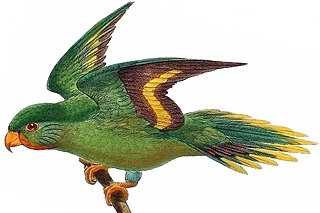
The red-chinned lorikeet is a species of parrot in the family Psittaculidae. It is native to New Britain, New Ireland, New Hannover and Karkar Island in Papua New Guinea.
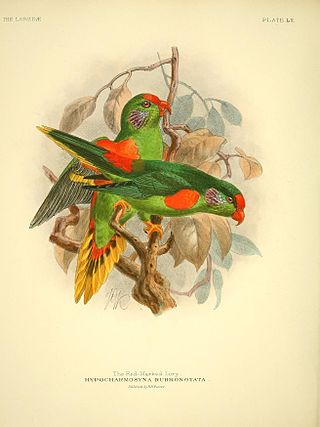
The red-fronted lorikeet, also known as the red-spotted lorikeet or red-rumped lorikeet is a species of parrot in the family Psittaculidae. It is found in northern New Guinea and the island of Biak. Its natural habitat is subtropical or tropical moist montane forests.

The pygmy lorikeet is a species of parrot in the family Psittaculidae. It is the only species placed in the genus Charminetta. It is found in the highlands of New Guinea; its natural habitat is subtropical or tropical moist montane forests. The world population of pygmy lorikeets is thought to be less than 50,000 individuals, but stable. They live at altitudes of 1000–2200m.

Psittinus is a genus of parrot in the family Psittaculidae. It was formerly considered to include a single species, the blue-rumped parrot, but the Simeulue parrot was split as a distinct species by the IOC in 2021. A 2019 genetic analysis found that the genus Psittacula is paraphyletic with respect to Psittinus, indicating that Psittacula may have to be split into different genera in order to maintain Psittinus as a distinct genus.

Parrots, also known as psittacines, are birds of the order Psittaciformes and are found mostly in tropical and subtropical regions. They are made up of four families that contain roughly 410 species in 101 genera. The four families are: Psittaculidae, the Psittacidae, the Cacatuoidea (cockatoos), and the Strigopidae. One-third of all parrot species are threatened by extinction, with higher aggregate extinction risk than any other comparable bird group. Parrots have a generally pantropical distribution with several species inhabiting temperate regions in the Southern Hemisphere, as well. The greatest diversity of parrots is in South America and Australasia.

The Mascarene grey parakeet, Mauritius grey parrot, or Thirioux's grey parrot, is an extinct species of parrot which was endemic to the Mascarene Islands of Mauritius and Réunion in the western Indian Ocean. It has been classified as a member of the tribe Psittaculini, along with other parrots from the Islands.

Psittrichasiidae is a family of birds belonging to the superfamily of the true parrots (Psittacoidea). It is a very small family, the smallest of the three families of the true parrots. It is divided into two subfamilies: Psittrichasinae and Coracopsinae, that contain a single genus each. The first contains a single species, native to New Guinea, and the second contains four living species distributed throughout Madagascar and other islands of the Indian Ocean.
The Moheli bulbul is a species of songbird in the bulbul family, Pycnonotidae. It is endemic to the Indian Ocean island of Mohéli. Its natural habitat is subtropical or tropical moist montane forests. Until 2011, it was classified as a subspecies of the Grand Comoro bulbul. It is also considered a sister species to the Seychelles bulbul.















